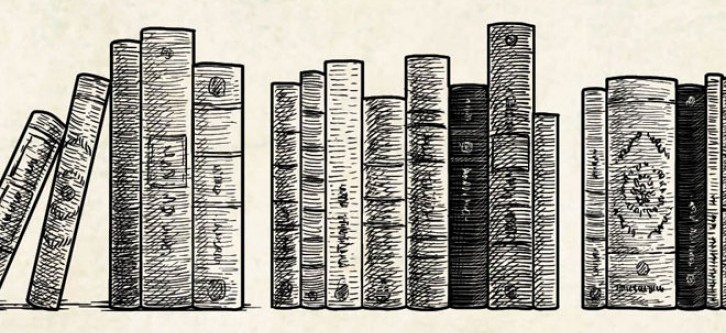In partnership with the Rare Books and Manuscripts Section Conference (Indiana University Bloomington, June 27-30, 2023) and the ABAA's in-person Booksellers' Showcase, the ABAA will offer a virtual showcase that everyone can visit, regardless of their location.
Doors will remain open continuously from Tuesday, June 27 at 12:00pm ET until Friday, June 30 at 8:00pm ET.
The RBMS Virtual Showcase will take place at www.abaa.org/vbf
Preview the exhibitors...
Enjoy this preview of selected books and ephemera that you'll find offered by ABAA members at the 2023 RBMS Booksellers' Virtual Showcase.
The Anatomical Eye Glass - The Best on the Face of the Earth
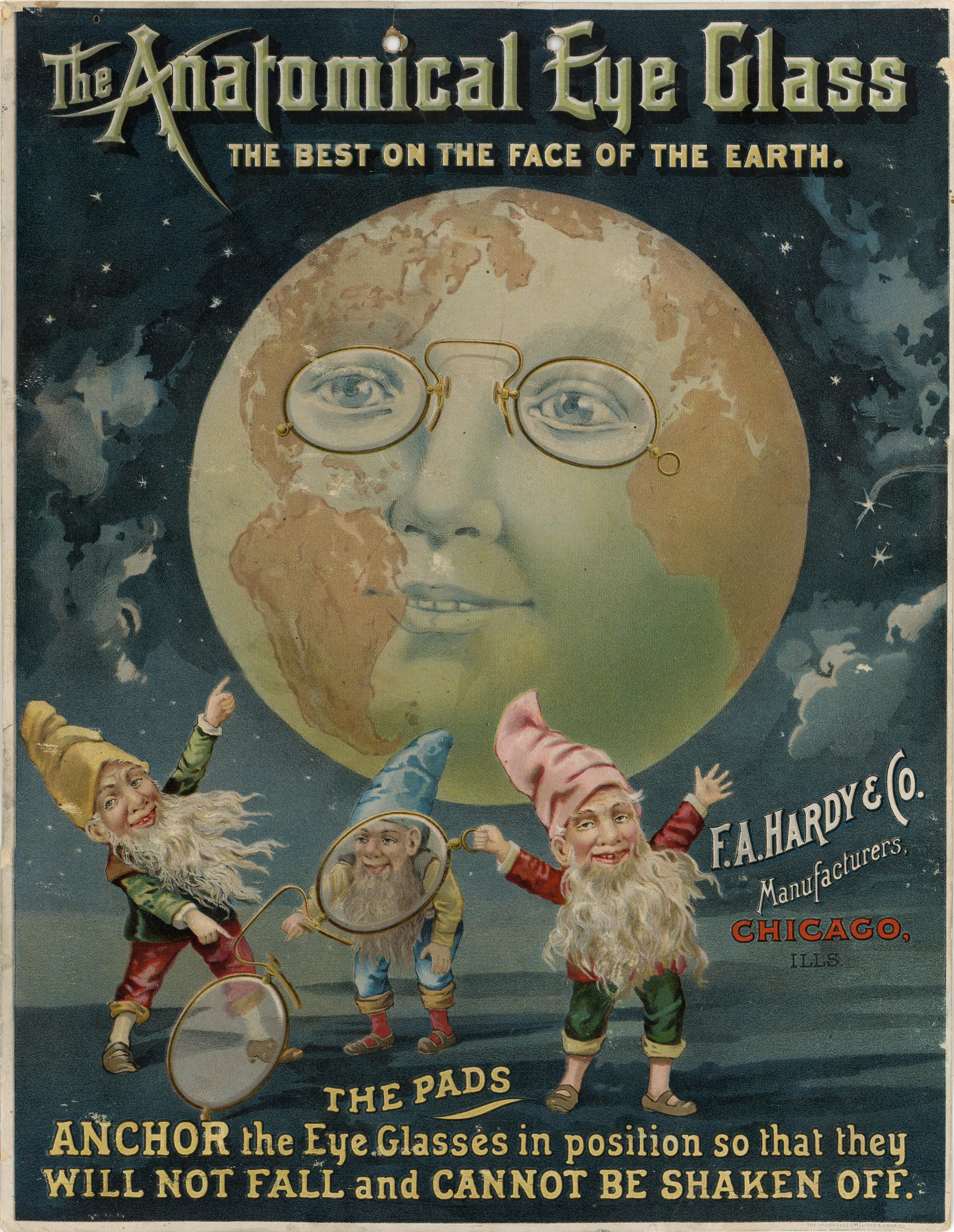
Milwaukee: The Milwaukee Litho & Engraving Co, 1902. Lightly warped. Scrapbook residue on reverse.. A fine 11.5" by 8/75" advertising trade sign or counter card. It depicts the earth wearing pince-nez --almost as though they were held in place by gravity. The three elves at the base hold a second pair and point to the nose pads. It is captioned "THE PADS ANCHOR the Eye Glasses in position so that they WILL NOT FALL and CANNOT BE SHAKEN OFF. Presented by F. A. Hardy & Co. Chicago ILL. Verso blank. Delightful eye-catching whimsy imparting a clear message on a new development in eye wear.
Offered by Eclectibles.
The Faerie Queene. A Poem in Six Books with the Fragment Mutabilitie. 6 volumes
Spenser, Edmund. Thomas J. Wise (editor); Walter Crane (illustrator)
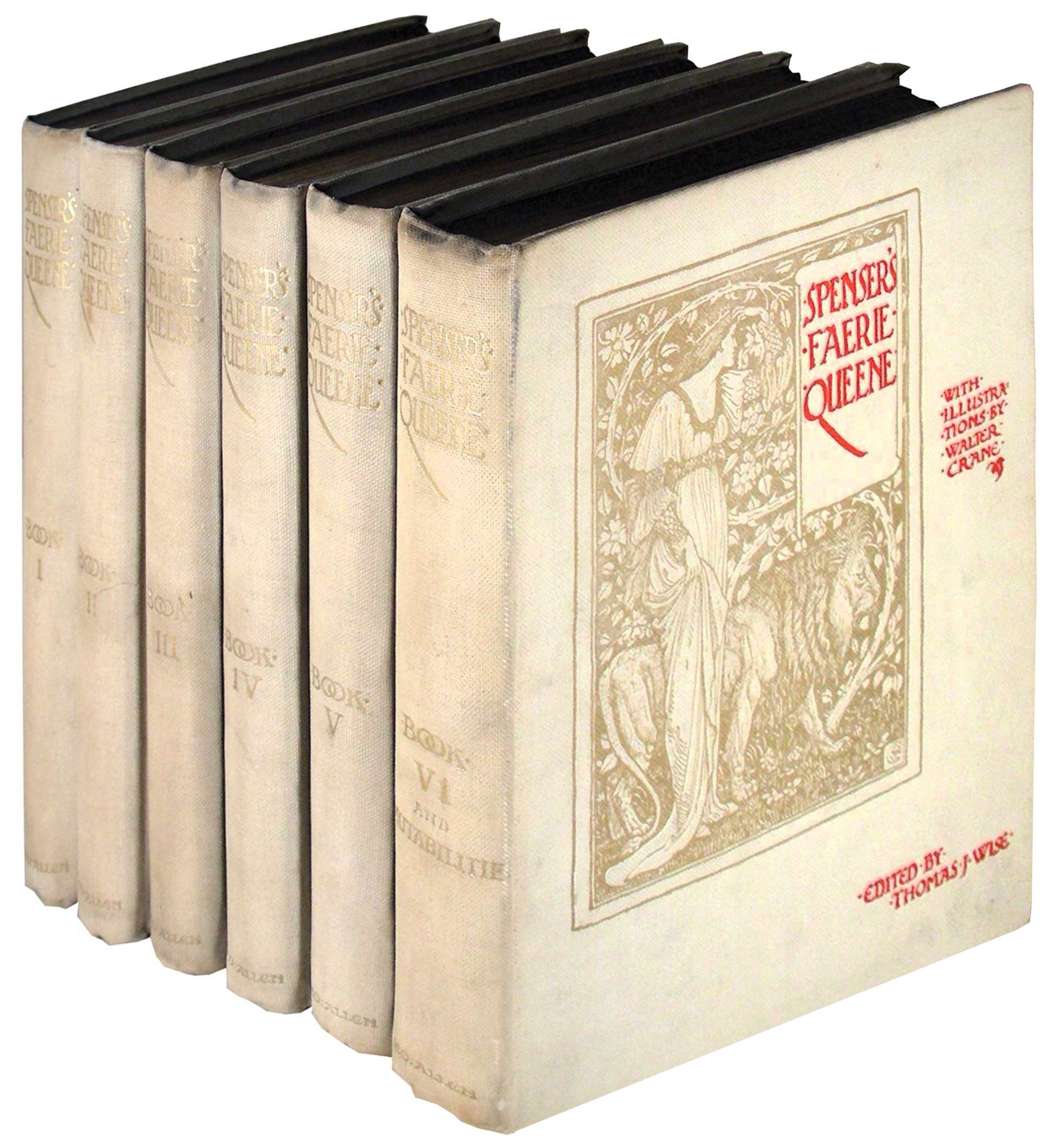
London: Printed at the Chiswick Press for George Allen, 1897. Hardcover. Very Good. Hardcover. One of 1000 sets on paper (there were an additional 28 on vellum). A magnificent edition of The Faerie Queene with Crane's glorious illustrations. Walter Crane (1845-1915) was renowned as an illustrator, artist, decorator, and designer during his career. This was Crane's most elaborate and extensive commission as a book illustrator. It was inspired by the revival of the private press, particularly the Kelmscott Press, as well as by the transition from Art Nouveau to Arts and Crafts, and by the importance of the illustrator in book production. Bound in white cloth, with gilt spine lettering plus red titling to front cover along with a large Art Nouveau design in gilt. This was originally issued in 19 parts, and all of the original salmon colored pictorial front wrappers are bound in. There are 88 mostly full page (one double page) black on white and white on black illustrations and 132 head or tail pieces, all from woodcut designs by Crane. The boards show very light wear and spines are slightly darker than covers. The texts are very tight throughout. Endpapers and pastedowns have varying degrees of foxing. Pages with some light aging to the margins and darkening to edges. First three pages of Volume I have brown splatters to bottom margins. Despite flaws still a beautiful set in very good condition.1546 pages.
Offered by Kelmscott Book Shop.
Musical Alphabet. [Board game prototype.]
Connolly, Kathryn
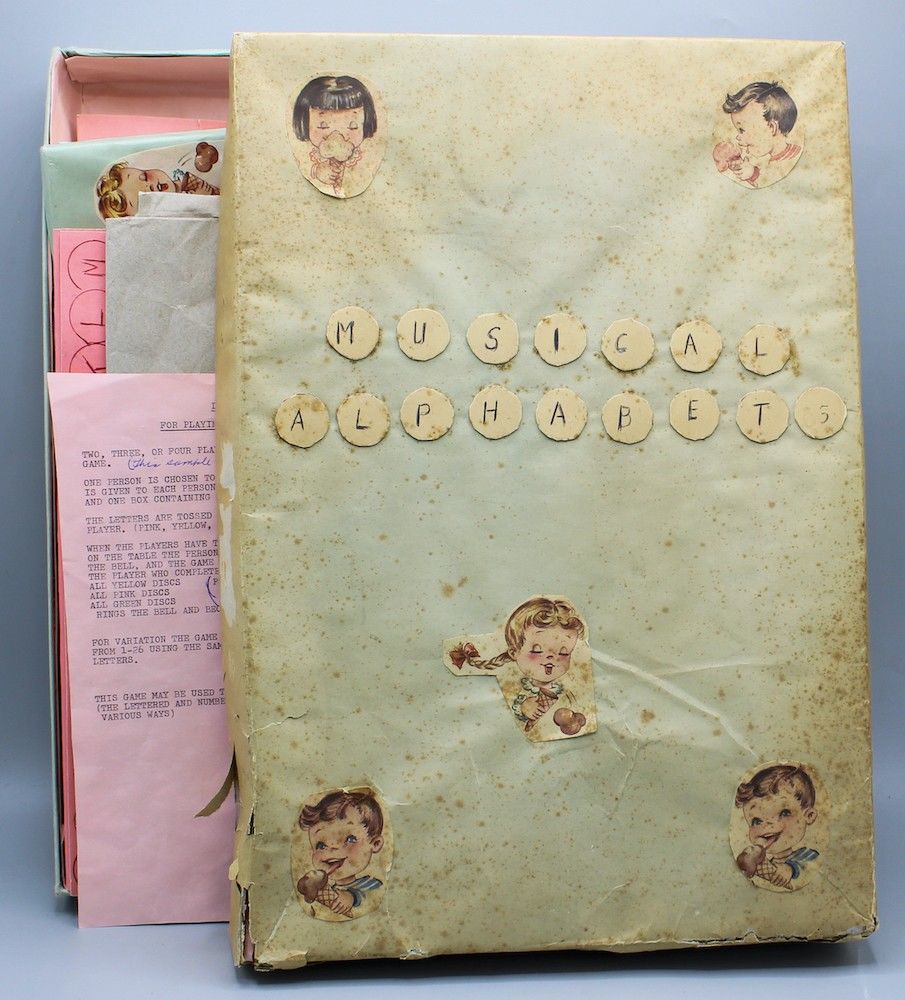
[Beverly, Massachusetts: Kathryn Connolly, 1958] A unique prototype for a board game that uses quick matching to teach children letters, numbers, and colors. The title might refer to the fast-moving party game musical chairs, as the game does not appear to have a musical component aside from a couple lines of verse written in manuscript on the game boards ("now I know my ABCs / I'm as happy as can be"). Paper-covered box with color illustrated onlays and the title spelled out on cardboard discs. . Paper-covered box (10 x 15 ") enclosing two game boards, two smaller decorated boxes containing game pieces, an instruction sheet, and a metal bell. Plus, a typewritten instruction sheet. All other text in manuscript. Foxing and toning to box. Materials inside are quite clean and well-preserved. Very good. According to the dealer who originally sold this item, Kathryn Connolly was a Milton Bradley employee, though the Musical Alphabet game was never produced by the company. Nevertheless, Kathryn Connolly has a place in the storied tradition of women game developers, the most notable of whom is probably Lizzie Magie, who originally patented the game that would become Monopoly. Magie, a leftist and feminist, developed the "Landlord's Game" as a microcosm and satire of capitalism. She filed a patent for the game in 1903 and published it two years later through the Economic Game Company that she co-owned. It was Charles Darrow and Parker Brothers that would take the credit for the game, though, buying up the rights to Magie's successful Landlord's Game in the 1930s and reissuing it as Monopoly.
Offered by Michael R. Thompson Booksellers.
The New and Complete Newgate Calendar; Or, Malefactor's Bloody..
Jackson, William; Lady Diana Duff Cooper her copy
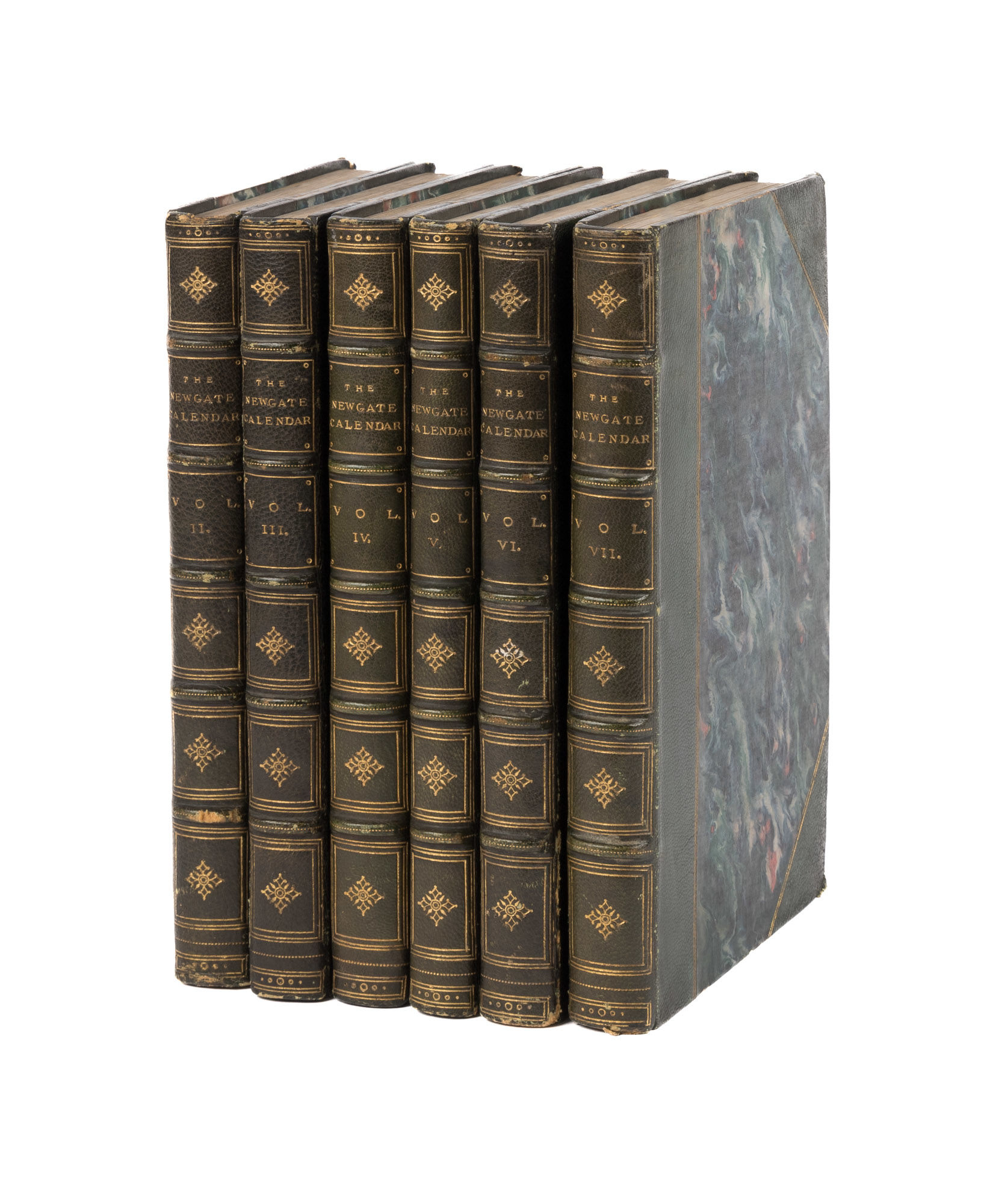
1818. A Handsome Set From the Library of Lady Diana Duff Cooper Jackson, William, Principal Author. The New and Complete Newgate Calendar, Or, Malefactor's Universal Register. Containing, New and Authentic Accounts of the Lives, Adventures, Exploits, Last-Dying-Speeches, Confessions, (As well as Letters to their Relatives, never Before Published) Of the Most Notorious Criminals, and Violators of the Laws of their Country (of Both Sexes and All Denominations), Who Have Suffered Death, And Other Exemplary Punishments, For Murder, Burglary, Felony, Horse-Stealing, Bigamy, Forgery, Highway Robbery, Footpad Robbery, Perjury, Piracy, Rapes, Riots, Mobbing, Sodomy, Starving to Death, Sheep-Stealing, Swindling, Treason, Mutiny, Sedition, And Other Misdemeanors. Interspersed with Notes, Reflections, Remarks, And Inferences, Arising from the Several Subjects, Moral, Instructive, And Entertaining. Comprehending the Most Material Passages in the Sessions Papers for Upwards of a Century; Together with the Ordinary of Newgate's Account of the Capital Convicts; And Complete Narratives of the Most Remarkable Trials. The Whole Containing the Most Faithful Narratives ever Yet Published of the Various Executions, And Other Exemplary Punishments, Which Have Happened in England, Wales, Scotland, And Ireland, From the Year 1700 to the Present Time. The Whole Properly Arranged from the Records of the Courts. London: Printed for Alexander Hogg & Co., Paternoster-Row, 1810. Six volumes, in seven books. Complete set. Pagination occasionally irregular, text complete. 39 engraved copperplates, 6 of them frontispieces. Octavo (8-1/2" x 5-1/2"). Near-contemporary three quarter morocco over marbled boards, gilt rules to boards, raised bands and gilt titles and ornaments to spines, top-edges gilt, deckle fore and bottom-edges, marbled endpapers. Negligible light rubbing and a few minor scuffs to boards, faint crease to front board of Volume II, some rubbing to spines, corners bumped and somewhat worn, front hinges of Volume I and II cracked, other hinges starting, bookplate of Lady Diana Duff Cooper to front pastedowns. Moderate toning to interiors, light foxing and faint dampstaining in a few places, faint offsetting from plates, repairs to corners of a few leaves with no loss to text. A handsome set.
Offered by Lawbook Exchange.
The Raven
Poe, Edgar Allan; Gustave Doré and Edmund C. Stedman (Commentary)
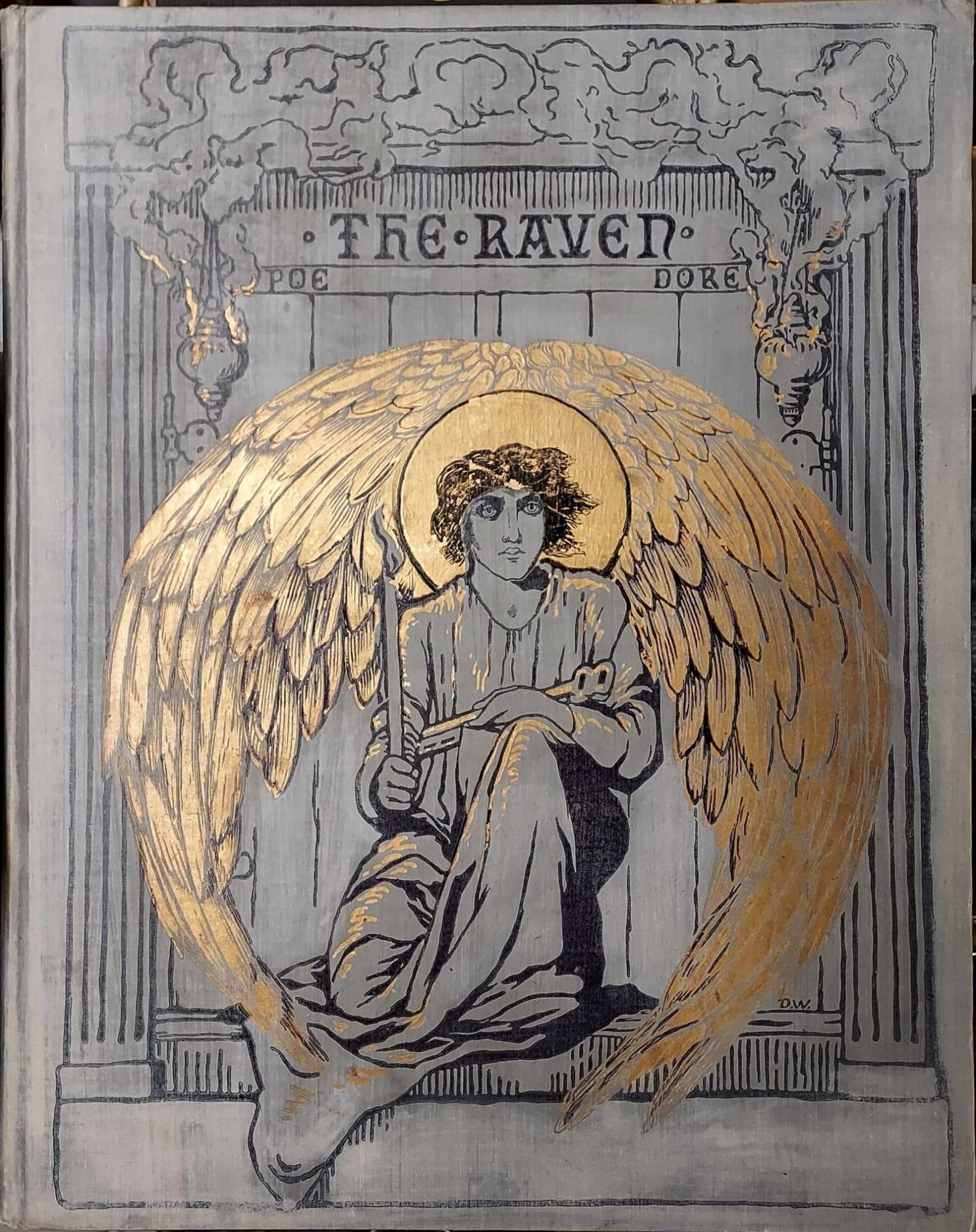
New York: Harper & Brothers, Publishers, 1884. First edition illustrated by Doré. Hardcover. Very good +. Gustave Dore. Elephant folio [46.5 cm] Gray pictorial cloth with full-cover angel illustration by Doré stamped in gold and black on the front board, with light wear to the extremities. Title page designed by Elihu Vedder. All edges gilt. There are a couple of areas where the text block is just beginning to crack. Complete, all illustrations present. **** Will require extra postage due to size and weight. Illustrated with twenty-six steel engravings by the preeminent French Victorian engraver, Gustave Doré. A bright and fresh copy, and a first edition thus, of this beautifully illustrated edition of the classic Poe poem.
Offered by Ken Sanders Rare Books.
A True Family Business: Fantastic Photographic Ad Card for Frank H. Hews Dry Goods, Lowville, NY c1900
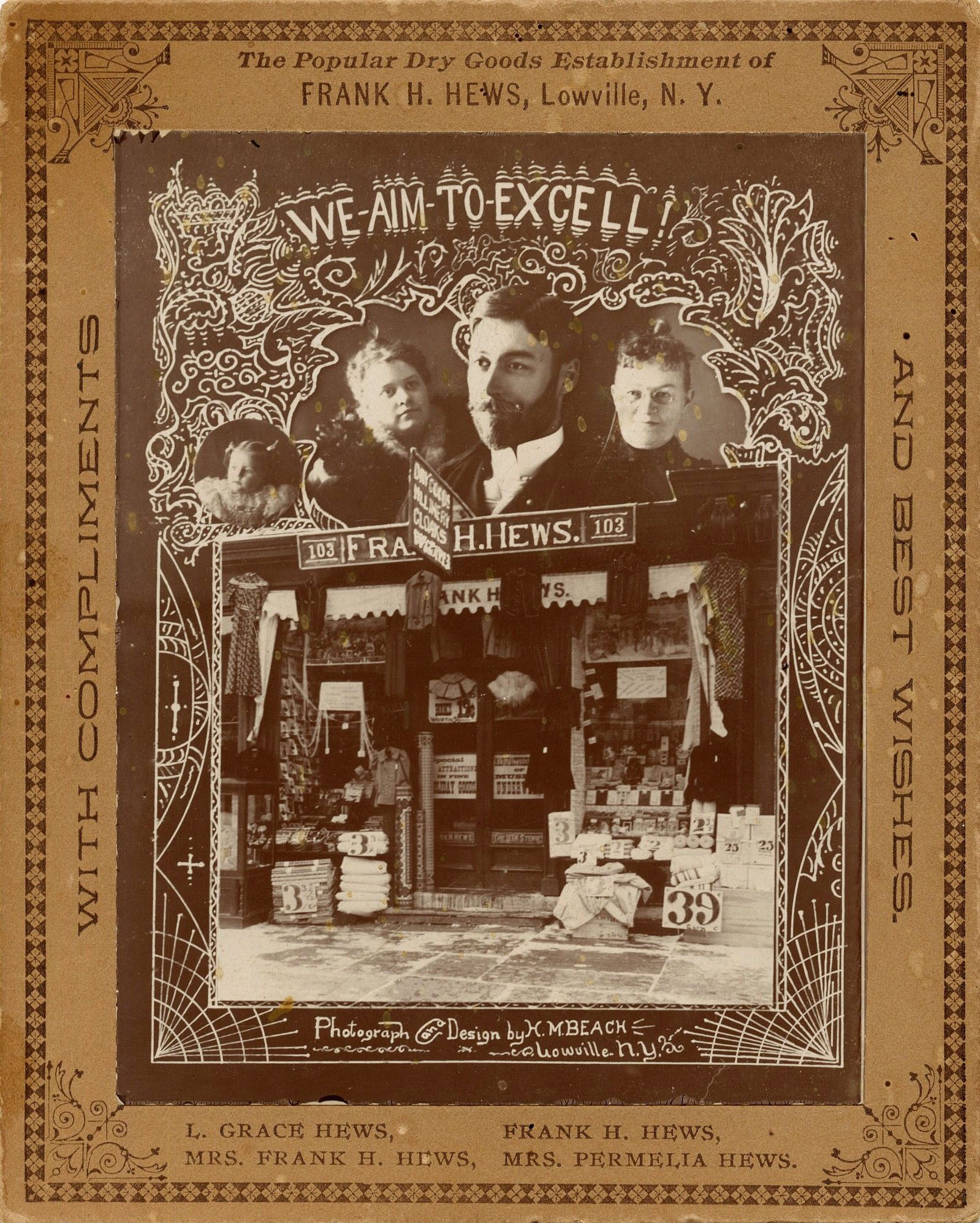
Not only is Hews' face on the card, but his wife, mother, & young daughter also take center stage. Surely his wife and mother helped to run the store? The photographer and card's designer was H.M. Beach, also of Lowville. The back of the card trumpets about the store and lists what they sell.
It measures 4 x 5 inches and is in very good condition with a few spots and slight edge wear.
Offered by Erin Waters Fine Photographs.
De veritate religionis Christianae amica collatio cum erudito Judaeo (A Friendly Conversation with a Jew Concerning the Truth of the Christian Religion [WITH] Exemplar humanae vitae (An Example of a Human Life) [AND] Brevis refutatio argumentorum quibus Acosta omnem religionem revelatam impugnat (A Brief Refutation of the Arguments in Which Acosta Attacks All Revealed Religion)
Limborch, Philippus van; Isaac de Orobio de Castro; Uriel da Costa
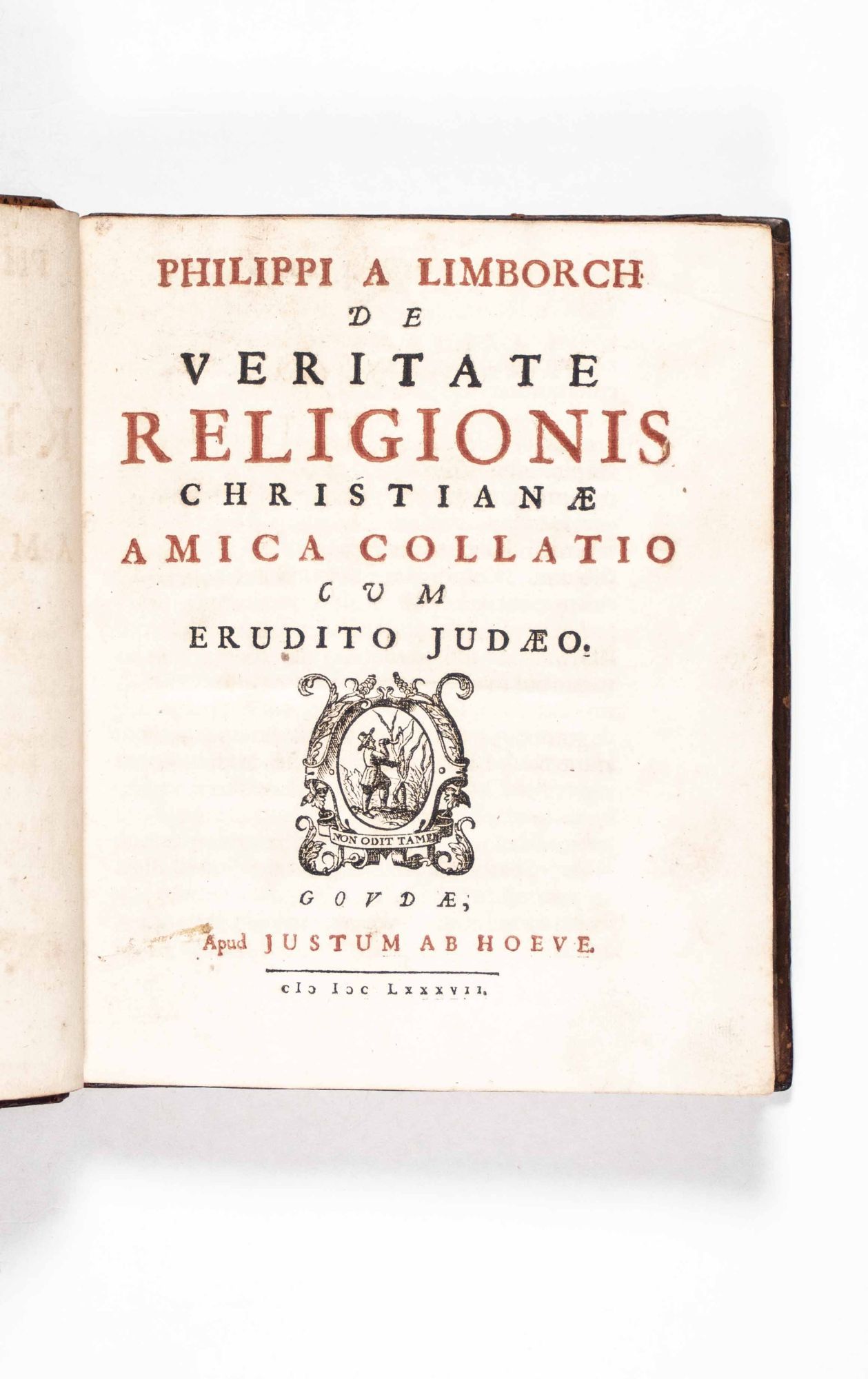
Gouda: Justus van der Hoeve, 1687. First edition. Hardcover. Fine. Three parts, quarto. [asterisk]-[2 asterisk]4 A-3A4 3B (= 197 leaves; K2 signed H2). [16], 364, [14, index]pp. Title in red and black, printed marginalia, woodcut tailpieces. Contemporary paneled calf (expertly rebacked to style), gilt lettering piece. Occasional touch of mild foxing, else a fine, crisp, amply-margined copy.
First edition of this remarkable collection, modeled on a work of Hugo Grotius with the same title, including the transcription of an epistolary debate between the Dutch theologian, Phillip van Limborch (1633-1712) and the Jewish scholar, Isaac Orobio de Castro (ca.1617-1687). Jonathan Israel views the work as "a key exemplum of the new 'enlightened' method of upholding Christianity." Limborch was a leading Dutch theologian aligned with the Arminians, and professor in the Seminary of the Remonstrants at Amsterdam. Orobio de Castro had been Professor of Theology at Salamanca who was imprisoned by the Inquisition on account of his sympathy with the Jews of Spain. He fled the country, going first to France and then to Holland, where he abjured Christianity, and became deeply involved in the philosophico-religious controversies in the Low Countries. In the present work, Limborch publishes three letters written by Orobio de Castro, along with his own detailed responses. In arguing against the "truth" of the Christian religion "Orobio retorted that the advent of Christ has done nothing to render mankind less sinful or to lessen suffering, that the rise of Christianity, far from being unparalleled, was surpassed by the expansion of Islam... and that far from being unchallengeable, Christ's miracles had not been performed publicly, like the miracle at Mount Sinai, but virtually in secret, a circumstance which renders them entirely dubious. These responses and his further claims that the New Testament is unreliable, providing no basis for trust in Christ's miracles, since the text exists only in Greek, a language neither Jesus nor the Apostles had the slightest knowledge of... made no impact on Limborch, Le Clerc, or Locke, who were convinced of their triumph over Orobio. Nevertheless, Orobio's arguments were fully and objectively reported in the text, and subsequently widely read across Europe, and some of those who read it were not so sure that Orobio was 'vanquished'. Boulainvilliers, who meticulously examined the text, concluded that Limborch's arguments were less securely grounded on reason than he and his allies supposed and that, even without their realizing it, it was Orobio who won the contest, a verdict echoed in other anti-Christian clandestine philosophical literature of the early eighteenth century" (Israel).
Edited from a manuscript formerly in the possession of the Leiden professor of theology, Simon Episcopius, and now in the University Library Amsterdam, the Exemplar Humanae Vitae is the autobiography of the Portuguese Jew, Uriel da Costa (ca.1585-1640), who was excommunicated from the Sephardi Jewish community of Hamburg in 1618 after addressing a polemical broadside to the leaders fo the Sephardi congregation of Venice, in which he criticized rabbinic Judaism as incompatible with the Torah. He later settled in Amsterdam where he submitted to a public recantation of his views before the Portuguese Jewish congregation, and committed suicide shortly thereafter. A radical freethinker who here makes an imposing plea against dogmatics, da Costa may be viewed as a forerunner of Spinoza. An English translation was published at London in 1740; a complete edition of his (few) works was edited in 1922 by Carl Gebhardt (Schriften des Uriel da Costa), and published as the second volume of the Bibliotheca Spinozana. At the conclusion, Limborch offers his refutation of da Costa's challenge to revealed religion. References: Bamberger, no. 67. Fürst 1:17. De Graaf, Cat. 70: Spiritualists, Nonconformists & Dissenters, no. 360. J. Israel, Radical Enlightenment (OUP, 2001), esp. pp. 464-466. Oscott Catalogues: Recusant Books (part 2), no. 2286; The Old Library (part 2: Bible Collections), no. 895. For Da Costa's Exemplar, cf. Roth B18.30, citing the English version of 1740. The work was already scarce and much sought after in the early modern era, as evidenced by: DeBure (Theology), no. 583: "ouvrage estime & recherche, les exemplaires en sont peu communs" and Osmont, Dictionnaire, vol. 1, p.406: "rare et estimé." In his 1694 catalogue of Christian Hebraic works, Bibliotheca Latino-Hebraica, Carlo Imbonati offers a surprisingly long discussion of De Veritate on pp. 201-209.
Offered by Eric Chaim Kline Bookseller.
Literature on Film.
Publicity for book-based movies for the Scandinavian market.
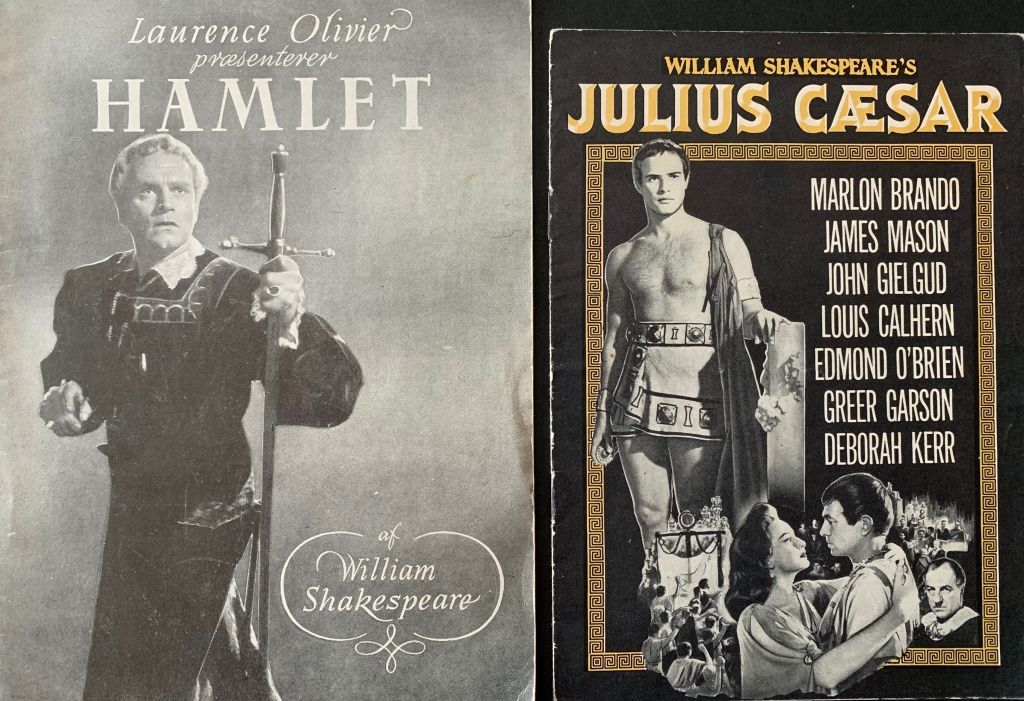
An assembled collection of 122 different promotional booklets designed and printed exclusively for sale at movie theatres in Denmark, ca. 1949-1970. Each booklet is illustrated with stills from the productions, list of credits, and a plot synopsis. These booklets were a unique form of film promotion exclusive to Scandinavia, and unlike, for example, publicity in America, these booklets were actually sold by the theaters. The films covered here are listed by the English title of the book on which each film is based— although most of these films were re-titled for the Scandinavian market. Collectively this group is a fine resource for research into Hollywood use and adaptation of literature for mass entertainment, of performance art, and of graphic design, since many of the booklets used (and changed) graphics created for the original advertising (e.g., posters).
The group includes:
1001 Nights (Arabian Nights)
1984 (Orwell);
20,000 Leagues under the Sea (Verne)
4:50 from Paddington (Christie)
A Gentleman Goes to Town (Kellands)
A Streetcar Named Desire (Williams). THREE versions.
All the King's Men (Warren)
Anna Karenina (Tolstoi)
Auntie Mame (Dennis)
Barabbas (Lagerkvist)
Beggar's Opera, The (Gay)
Best Man, The (Vidal)
Big Clock, The (Fearings)
Blithe Spirit (Coward)
Breakfast at Tiffany's (Capote)
Bridges at Toko-ri (Michener)
Butterfield 8 (O'Hara)
Caine Mutiny, The (Wouk)
Call of the Wild [Charlton Heston version] (London)
Captain Blood (Sabatini)
Cavalcade (Coward)
Collector, The (Fowles)
Corsican Brothers, The (Dumas). Two versions of program.
Count of Monte Cristo, The [Jean Marias and Louis Jourdan versions]
Cyrano de Bergerac (Rostand)
David Copperfield (Dickens)
Diary of Anne Frank, The.
East of Eden (Steinbeck)
Egg and I (MacDonald)
Electra (Euripides)
End of the Affair, The (Greene)
Exodus (Uris)
Fahrenheit 451 (Bradbury)
Fallen Idol, The (Greene)
Fanny Hill (Cleland)
For Whom the Bell Tolls (Hemingway). TWO versions.
Four Horsemen of the Apocalypse, The (Ibanez)
From Here to Eternity (Jones)
From Russian with Love (Fleming)
Glass Menagerie, The (Williams)
Goldfinger (Fleming)
Gone With The Wind (Mitchell)
Gulliver's Travels (Swift)
Gunga Din (Kipling)
Hamlet (Shakespeare), Olivier and Kruger versions
Hiroshima, Mon Amour (Duras);
Hud (McMurtry)
Hunger (Hamsun)
Ice Palace (Ferber)
Jane Eyre (Bronte) [George C. Scott and Orson Wells productions]
Julius Caesar (Shakespeare)
La Romana (Moravia)
Les Liaisons Dangereuses (Laclos)
Little World of Don Camillo, The (Guareschis)
Lolita (Nabokov)
Lost Weekend (Jackson)
Love Story (Segal)
Man in the Gray Flannel Suit (Wilson)
Man in the Iron Mask (Dumas)
Marty (Chayefsky)
Mildred Pierce (Cain)
Misfits, The (Miller)
Moby Dick (Melville)
Murder Most Foul (Christie)
My Outlaw Brother (Max Brand)
Nana (Zola)
Of Human Bondage (Maugham)
Old Man and the Sea, The (Hemingway)
On the Waterfront (Johnson)
Our Man in Havana (Greene)
Passionate Friends, The (Wells)
Pastorale Symphony, The (Gide)
Paths of Glory (Cobb)
Peyton Place (Matalious)
Pinocchio [Disney/ KKO prod.] (Collodi)
Postmaster, The (Pushkin)
Prisoner of the Iron Mask [Michel Lemoine], The Man in the Iron Mask [Louis Hayward]
Psycho (Bloch)
Pygmalion (Shaw)
Robinson Crusoe (Defoe)
Romeo & Juliet (Shakespeare)
Rose Tattoo, The (Williams)
Sanctuary (Faulkner);
Saturday Nights and Sunday Morning (Sillitoe)
Shane (Stevens)
Spartacus (Fast)
Spy Who Came in from the Cold, The (Le Carré)
Strange Door, The (Stevenson)
Stranger, The (Camus)
Sun Shines Bright, The (Cobb)
Sweet Bird of Youth (Williams)
Talismen (Walter Scott)
Taming of the Shrew (Shakespeare)
Tarzan's Secret Treasure (Burroughs)
The Big Sleep (Chandler)
The Crucible (Miller)
The Fixer (Malamud)
The Leopard (De Lampedusa)
The Naked and the Dead (Mailer)
The Vanishing American (Zane Grey)
Thérèse Raquin (Zola)
They Shoot Horse Don't They? (McCoy)
Three Muskateers (Dumas)
Three Penny Opera (Brecht)
Tobacco Road (Caldwell)
Tom Jones (Fielding)
Unconquered (Swanson)
Viva Zapata! (Steinbeck)
War and Peace (Tolstoi)
War of the Worlds (Wells)
Washington Square (James)
Watch on the Rhine (Hellman)
When Tomorrow Comes ["A Modern Cinderella] (Cain)
Witness for the Prosecution (Christie)
Wuthering Heights (Emily Bronte)
Zorba the Greek (Kazantsakis)
Offered by Marc Selvaggio, Books & Ephemera.
Of The Advancement And Proficience of Learning or the Partitions of Sciences IX Bookes Written in Latin by the Most Eminent Illustrious & Famous Lord Francis Bacon Baron of Verulam Vicont St Alban Consilour of Estate and Lord Chancellor of England. Interpreted by Gilbert Wats
Bacon, Sir Francis (1561-1626)
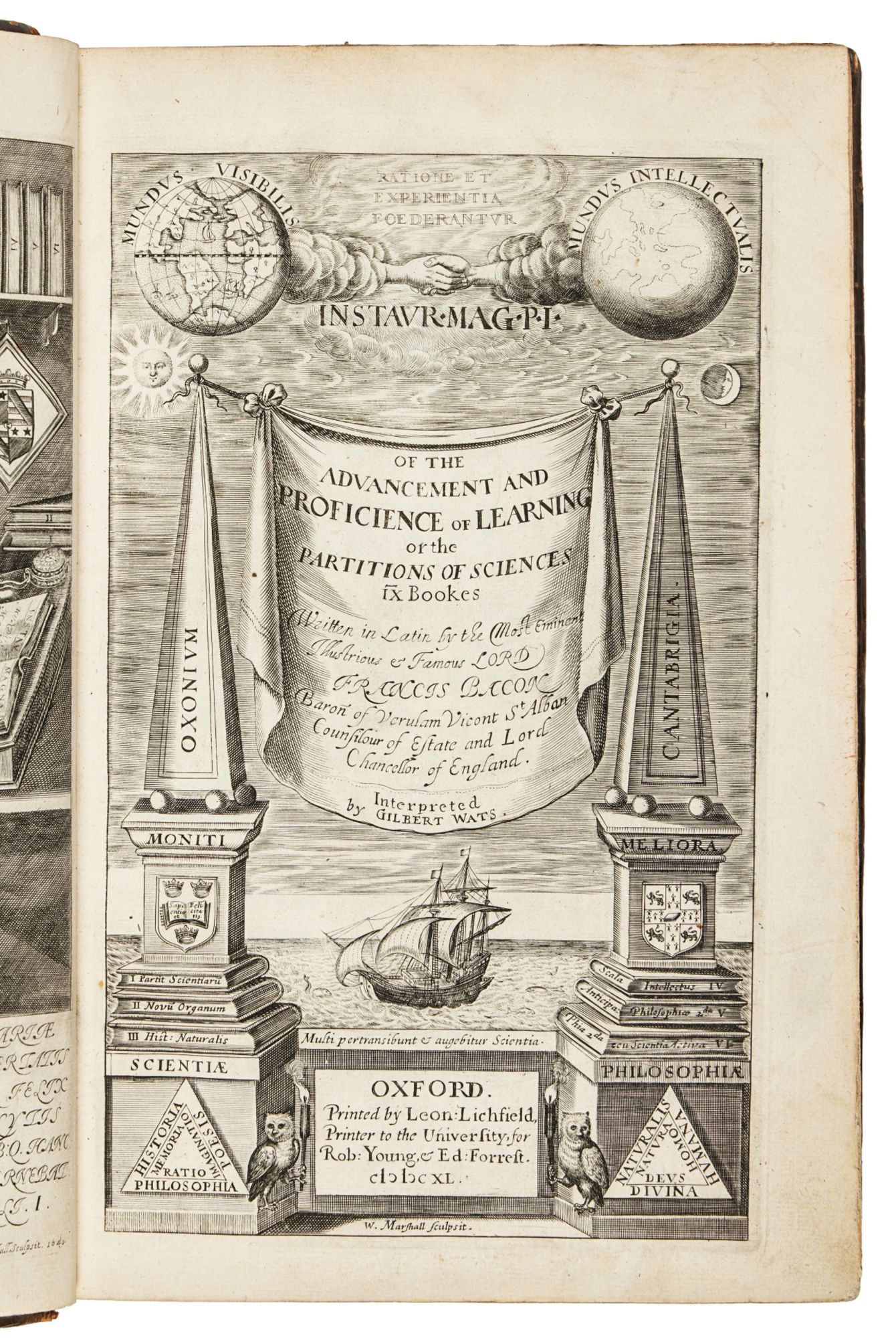
Oxford: Printed by Leon: Lichfield, Printer to the University, for Rob: Young, & Ed: Forrest, 1640. FIRST COMPLETE EDITION in ENGLISH, second issue, with the colophon dated 1640. Hardcover. Fine. An excellent copy bound in attractive contemporary calf, boards ruled in blind and gold, with ornaments at the angles and diamond-shaped cartouche at center; spine tooled with ornaments, gilt. The binding is in fine shape with minor defects to the head and tail of spine, mild wear to hinges and extremities. The portrait and engraved title are both present. Contents fine with a few trivial blemishes. Early ink inscription on fly-leaf. Fore-edge of portrait leaf slightly curled and lower margin lightly soiled. Small ink stain on lower blank margin of portrait leaf, light ink smear on margin of leaf A1, damp-stain in margin of lvs. G2-3 and Ooo4, small rust hole on leaf M2, a few spots on lvs. Qq1-3. With an inscription in cipher on the rear endpaper. This is the important English translation, by Isaac Watts, of Bacon's "De augmentis scientiarum" ("Partitions of the Sciences"), a greatly expanded version of Bacon's "Of Proficience and Advancement of Learning Divine and Human"(1605). The work forms part one of Bacon's "Instauratio Magna", a foundational work of Early Modern science. The "Advancement" was first published in two books. In its present, final form, it has been expanded to nine.
"Bacon's major contribution to the development of science lies in his natural philosophy, his philosophy of scientific method, and in his projects for the practical organization of science. During the last years of his life, he expounded these ideas in a series of works, of which the 'Twoo bookes: Of the proficience and advancement of Learning, divine and humane' was the first. The only work Bacon ever published in English, it was later expanded and Latinized into 'De augmentis scientiarum' (1623). In the 'Twoo bookes', Bacon concerned himself primarily with the classification of philosophy and the sciences and with developing his influential view of the relation between science and theology. While preserving the traditional distinction between knowledge obtained by divine revelation and knowledge acquired through the senses, Bacon saw both theoretical and applied science as religious duties, the first for a greater knowledge of God through his creation, and the second for the practice of charity to one's fellows by improving their condition. This view of science as a religious function maintained its authority throughout the seventeenth and early eighteenth centuries, and was an important factor in the public success of the scientific movement." (Norman Library)
"Bacon's grand motive in his attempt to found the sciences anew was the intense conviction that the knowledge man possessed was of little service to him. 'The knowledge whereof the world is now possessed, especially that of nature, extendeth not to magnitude and certainty of works.' Man's sovereignty over nature, which is founded on knowledge alone, had been lost, and instead of the free relation between things and the human mind, there was nothing but vain notions and blind experiments. ... Philosophy is not the science of things divine and human; it is not the search after truth. 'I find that even those that have sought knowledge for itself, and not for benefit or ostentation, or any practical enablement in the course of their life, have nevertheless propounded to themselves a wrong mark, namely, satisfaction (which men call Truth) and not operation.'
'Is there any such happiness as for a man's mind to be raised above the confusion of things, where he may have the prospect of the order of nature and error of man? But is this a view of delight only and not of discovery? Of contentment and not of benefit? Shall he not as well discern the riches of nature's warehouse as the beauty of her shop? Is truth ever barren? Shall he not be able thereby to produce worthy effects, and to endow the life of man with infinite commodities?' Philosophy is altogether practical; it is of little matter to the fortunes of humanity what abstract notions one may entertain concerning the nature and the principles of things. This truth, however, has never yet been recognized; it has not yet been seen that the true aim of all science is 'to endow the condition and life of man with new powers or works,' or 'to extend more widely the limits of the power and greatness of man.'"(Encyclopedia Britannica, eleventh edition, vol. 3, page 145.).
Offered by Liber Antiquus.
Cool Still-Life of a Fan with a Calendar Design Made of Postage Stamps, c1930 Photo Postcard
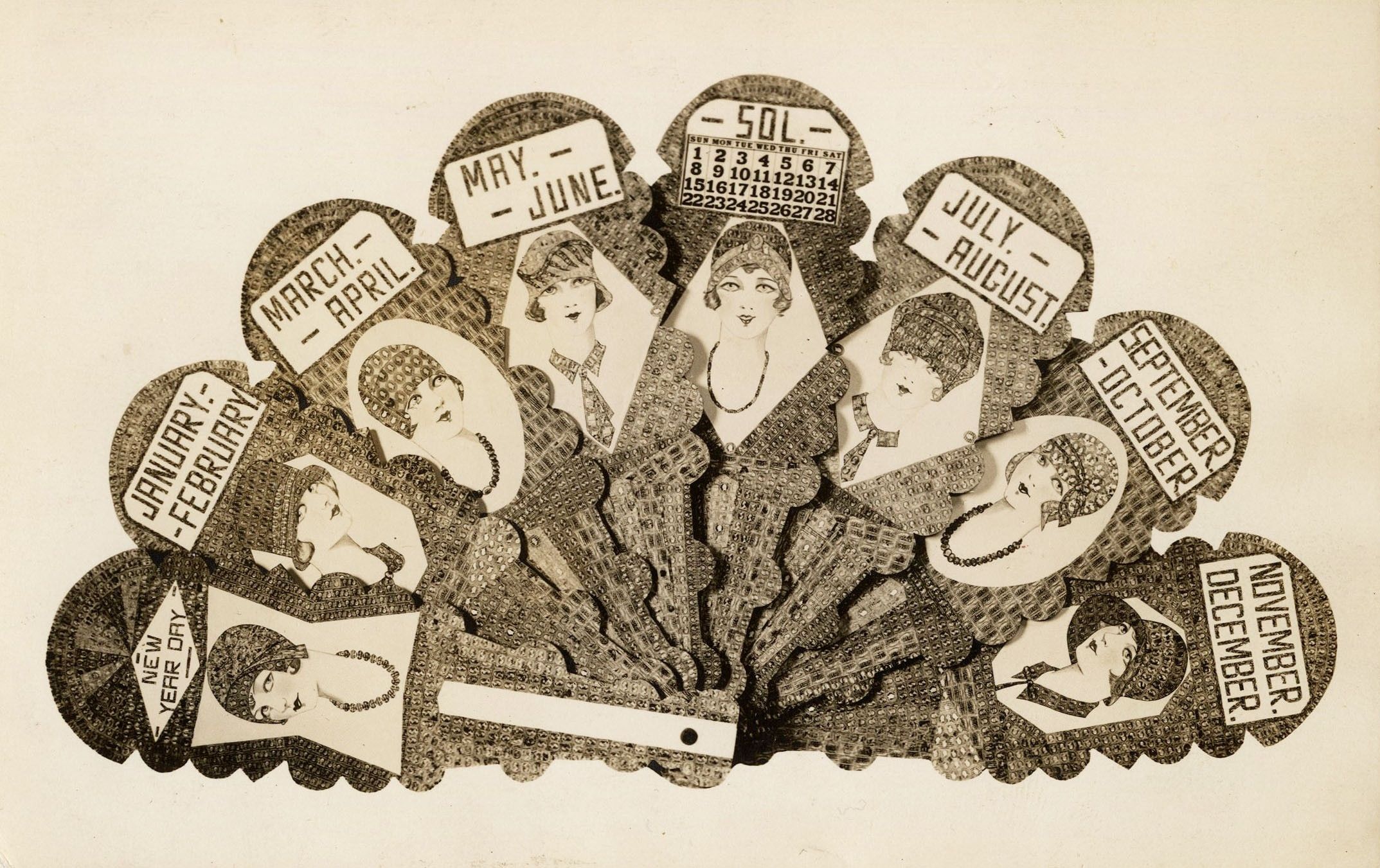
I can't imagine the amount of work that went into making the fan. Each flapper's face has a different personality. Can you imagine finding the actual object? The image is in fine condition. There is no ID.
Offered by Erin Waters Fine Photographs.
CRITICA SYNOPSIS DE LA CIRUGIA, Y COMPENDIO PRACTICO MANUAL DE SUS OPERACIONES
Publica en Lengua Española DON ANDRÉS GARCIA VAZQUEZ
Mr. Samuel Sharp
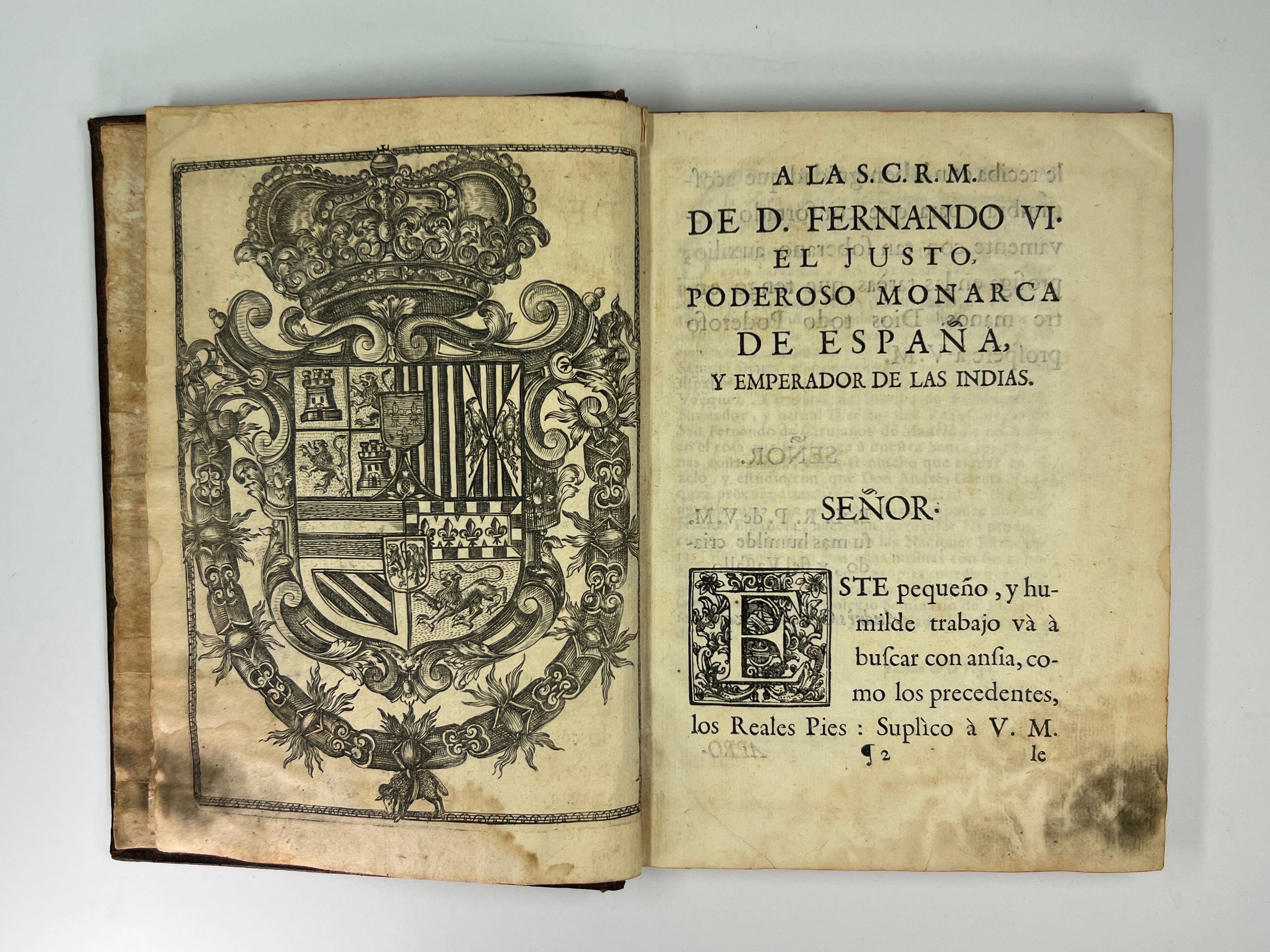
Medicine in Spain, 18th Century: Very Rare First Spanish Edition of a Classical Surgical Work. Worldwide, Copies are Only Found in 3 Institutions. Complete Copy with All Illustrations. Sharp, Samuel Mr. (170?/1778).
"CRITICA SYNOPSIS DE LA CIRUGIA, Y COMPENDIO PRACTICO MANUAL DE SUS OPERACIONES COMPUESTO POR EL CÉLEBRE INGLÉS Mr. Samuel Sharp, Cirujano del Hospital de Guy de Londres, enriquecido con estampas finas, que arreglado á la quinta impresión del Autor: Publica en Lengua Española DON ANDRÉS GARCIA VAZQUEZ, Cirujano de Familia de S. M. Fundador, y actual Director del Real Colegio de San Fernando de Cirujanos de Madrid, etc. AL REY NUESTRO SEÑOR- con privilegio. En Madrid: En la Oficina del Mercurio, por Joseph de Orga, Impressor. Año de 1753. Se hallará en la Libreria de Alonso Martin, con las Obras de Heislér, y Genga, frente de San Phelipe el Real".
Complete copy. Pagination: (24), 276- (4), and 1 missing blank page. Heraldic sculpture and 15 illustrated sheets depicting surgical instruments. Apart from 4 pages at the beginning and 5 at the end, which have ancient humidity stains, the copy is in excellent condition: both the text and illustrations are impeccable.
Offered by Elena Gallego Rare Books.
Jeu de la Grande Roue de Paris
The Ferris Wheel at the Paris Exposition
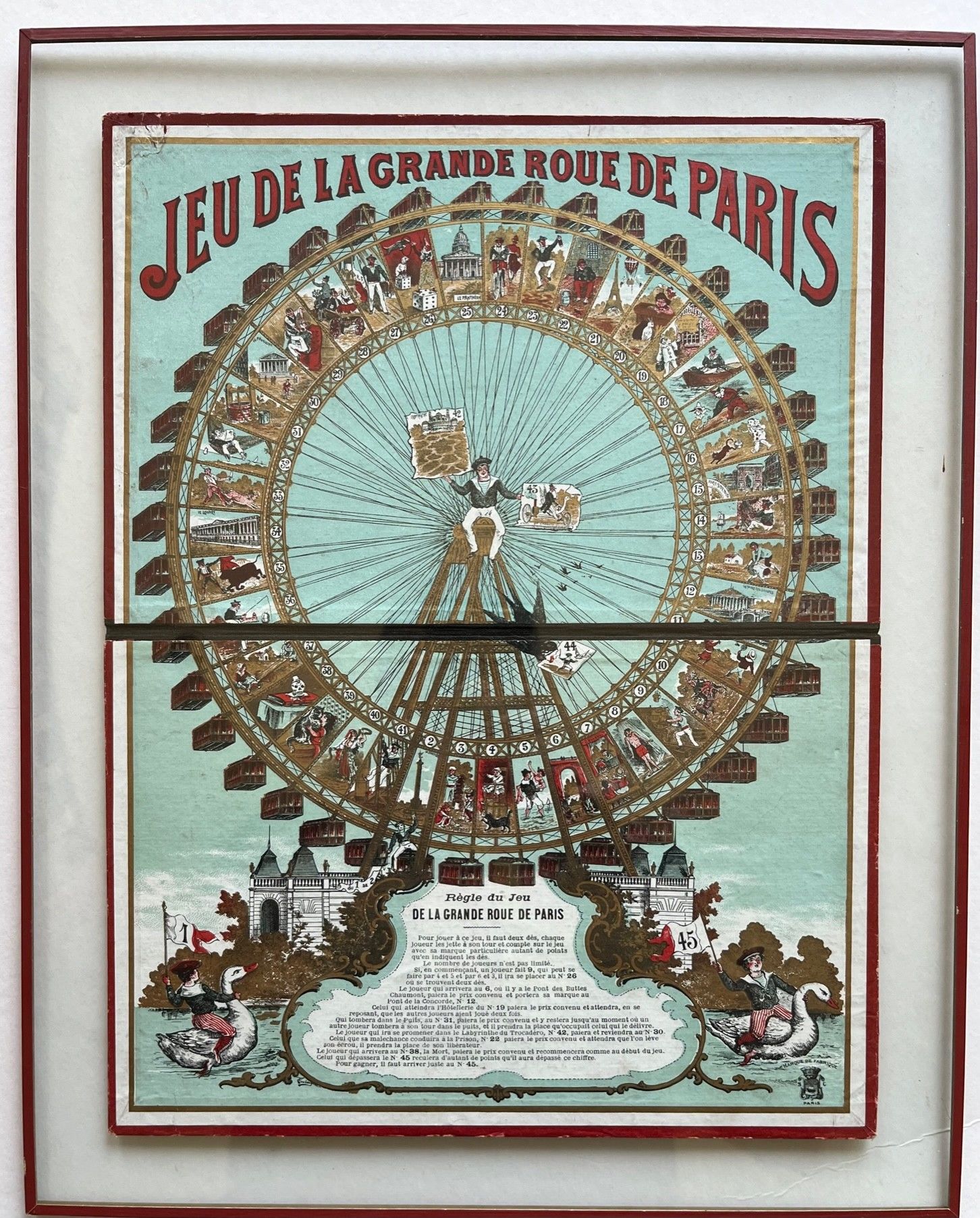
Foldded printed bard game published on the occasion of the Exhibition Universelle in Paris in 1900. Adorned with a beautiful chromolithograph in mainly red, white and gold tones. This is a jeu de l'oie (goose-type) game, with only 45 squares, and is illustrated with characters, comic sketches or emblematic Parisian monuments. The title is inscribed in red capitals at the top, while at the bottom, the base of the Ferris Wheel leaves room for the rules of the game (printed in black) and at the start and finish squares (No. 1 and 45), symbolized by children in tricolor costumes riding geese and waving banners. Slight ding in the upper left cover of the board, otherwise a very good copy of this rare toy.
Once a manufacturer "of boxes of all kinds," Lucien Napoléon Simonin and Agathe Cuny, his wife, founded the firm in the years 1880-1890 in Gérardmer (Vosges). Gradually the company evolved into manufacturing toys (dolls, cutlery sets, figurines) and board games. In 1898 they established the firm at 156 rue Oberkampf in Paris, and adopted as its logo the initials of its leaders framing the arms of the capital. Like many of their colleagues, the couple drew inspiration from current events for its creations. In this case, the Ferris wheel built as the emblem of the Exhibition Universelle. The Wheel was erected at avenue de Suffren, opposite the Galerie des Machines, and its dimensions recall the gigantism of the Eiffel Tower created for the 1889 Exhibition: 93 m diameter with a pedestal of 3 m, which makes it culminate at 96 in height; with 40 13-meter-long cabins, each capable of transporting 30 people; and a steam mechanism with a power of 120 horsepower for turning the Wheel. The Wheel was the property of Théodore Vienne, founder of Paris-Roubaix, who also managed the attraction. In 1920-22, the wheel will be disassembled and dismantled. The passenger baskets were recovered by rag pickers to serve as stalls, later by antique dealers. The Simonin-Cuny house ceased its activity in 1904 when it was absorbed with Mauclair-Dacier, AGWL and others into the conglomerate JJF, French Games and Toys.
Offered by Marc Selvaggio, Books & Ephemera.
Collection of 28 Work Safety and Other Work-Related Posters
[Labor / WWII / Homefront]. Randall, Stan - Artist
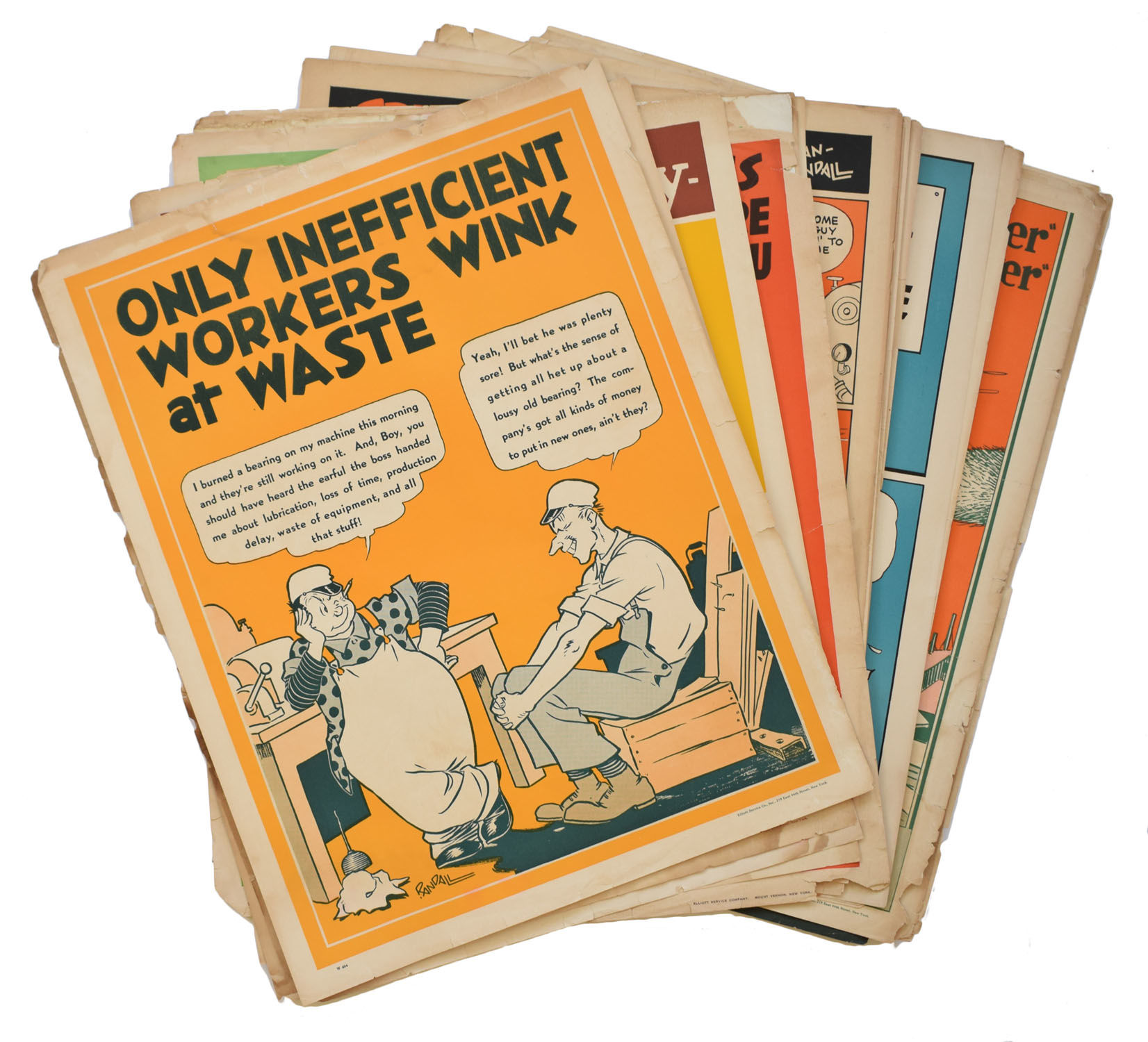
22 x 17 inches. 28 broadsides, including two duplicates. White stock printed in two additional colors. Condition varies, with some posters showing only minor wear but the majority with marginal chips, loss, and/or tears; old tape repair to verso some; significant dampstaining to three posters.
A collection of posters most likely issued during WWII, encouraging workers to use safety precautions, be efficient, work together, be responsible during off hours, and even smile at coworkers.
All of the posters were illustrated by Stan Randall, an artist who studied under Norman Rockwell and worked on early gag and humor comics like "Alfy Elephant" and "Slim Pickins". Randall also did the newspaper feature "Right Around Home" for two years in the 1950s, was an assistant on "Ripley's Believe it or Not", and did numerous commercial comic strips and promotional art.
Randall's comic strip background is clear in a series of eight posters (plus one of the duplicates) featuring two workers named Spec and Lumpy, who mean well but get into trouble with the boss through carelessness, forgetfulness, etc. Although none of these posters depend on the others, narratively, all but one are numbered in the lower righthand corner with a number from 2 to 8; it's possible that the first one was simply left unnumbered.
Elliott Service Co. was a subscription photographic and pictorial news service agency that provided images for display and advertising purposes throughout the 1920s and 1930s. Although we find no evidence of their wartime efforts, creating work safety posters was certainly in their wheelhouse.
Not located in OCLC or any other online resource.
Offered by Kate Mitas, Bookseller.
1841-1845 - An archive of correspondence between an exceptionally wealthy Massachusetts bootmaker-politician and his son regarding life as a student at Philips Exeter Academy and chronicling the devastating seven-year depression that followed The Panic of 1837
Nathaniel and George White
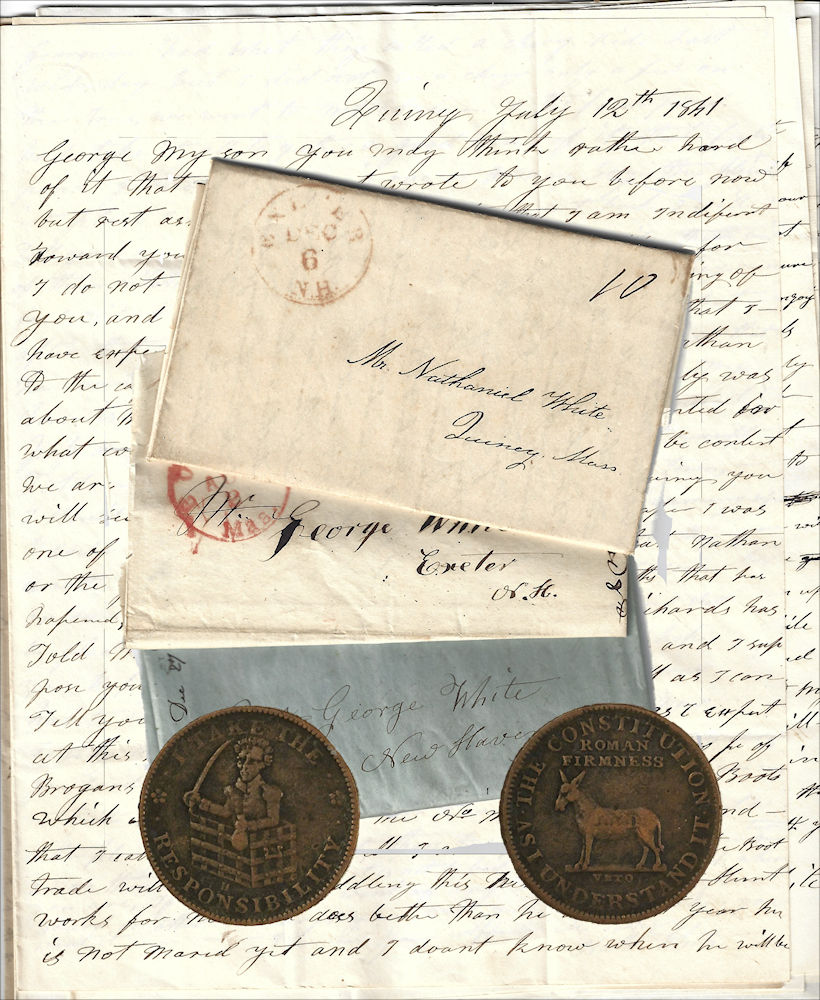
"My business it is not worth having. . .. I am [now] dismissing my thick shoe makers for I have no orders nor do I expect to have any and I have amost all my shoes on hand that I had made, several thousand pr at any rate. . .."
Quincy, Massachusetts and Exeter, New Hampshire, 1845.
This archive consists of nine stampless folded letters between Nathaniel White at Quincy, Massachusetts, and his son, George, who attended Philips Exeter Academy and later Yale. The letters were written between 1841 and 1845; eight were written by Nathaniel and one by George. The letters bear a variety of manuscript and hand-stamped postal markings. In nice shape. Transcripts provided.
The archive also contains two anti-Democrat "Hard Times" tokens, ridiculing Presidents Andrew Jackson and Martin Van Buren whose fiscal policies caused the American economy to crash and enter a depression as least as deep and catastrophic as that of the 1930s.
Nathaniel White was a prominent and extremely wealthy Democratic politician who had amassed a "fortune" in the shoemaking industry after it changed from a piece-work process into a central shop system that allowed for much greater production.
In the letters, without mentioning Jackson or Van Buren, Nathaniel (a staunch Democrat) describes the collapse of his shoemaking business, continued funding of George's education, his opposition to the Cold Water Party (a temperance faction of the Democrats associated with the Know-Nothings, and the mid-term election of 1842 which turned out the Quincy Democrats replacing them with Whigs.
A few excerpts include:
12 July 1841 - "I have sold about 2000 pr of the Brogans (that is rather slow,) . . . well I am in hopes that the Boot trade will be full middling this next fall. . .. If you are in want of any money to pay your Board, or other neccessarys you will just write say when you want it. . .."
30 July 1841 - "You ought not give your self any uneasiness on my account for I should not of undertaken [your enrollment at Exeter] had I not ment to go with you in all things necessary for your progression. . .. A. Wood &c has cum in & ordered 60 cases of Boots of different kinds and I must attend to my Business. . .. If I do not cum up you will hear from me in season to pay your board. . .."
5 November 1841 - (From George) "We are examined by the Teachers at the close of the 1 & 2 terms, and by the Trustees at the close of the 3d term. . .. Those who have not ambition enough to go ahead with their studies are those who have parts in the exhibition at the end of the. . .. Without your sustaining arm in pecuniary affairs my desires for a liberal education would come to naught. . .. My board will amount to $38. . ..I dont know about my wood but I think it will be about $5, and lights $1.25 and there are several books that is necessary that I should have one is Webster's Dictionary came to about $3.50 and Anthon's Classical Dictionary . . . costs about $5. and I shall have to purchase several Greek books. . .."
17 February 1842 - From Nathaniel: "I made a good years work last year nominally but how it will prove before I get my pay I know not, but think I shall loose 8 or 10 hundred dollers and the old debts I think much of it will go by the Bankrupt Law. . .. I can calculate rather over $3,000 loss in all . . . when I get rid of the old debts . . . I shall feel more comfortable. . .."
6 November 1842 - From Nathaniel: "Mr Gregory [the Universalist minister and leader of the Cold Water Party] has undertaken to drive every body to act & do as he does . . . and that makes a great deal of trouble. . .. At any rate . . . He will be arrested . . . for haveing 2 wifes and I do not see any thing to save him from the states prison. . .. My business it is not worth having. . .. I am [now] dismissing my thick shoe makers for I have no orders nor do I expect to have any and I have amost all my shoes on hand that I had made, several thousand pr at any rate, I have sold about 2200 pr of boots but sold low for the sake of selling. . .. Our election cums of now in about a weak. . .. There is so many parties I cannot give any gess how it will go in Quincy, about all they talk about is Gregory [who] I am afrade will throw us off the track. . .. I wish for you to keep along as tho you were sure of Receiving my aid . . . I shall not forsake you [unless] compelled to by poverty. . .."
27 November 1842 - Nathaniel: "You had better cum home . . . on account of expence in these hard times, your Board will cum to more than the expence home & back and your lights [and] fewell &c must cost more than in warm weather. . .. I should rather send less money now [just] what is necessary for the present term and then more when you want it. . .."
3 April 1843 - Nathaniel: "We 7 men by we [I mean] prety much all the old leading democrats were unsuccessful [at our town's] Citizens Meeting, which was on account of being split up by Gregory last fall at that meeting. . .. The result was all the Whigs were elected. . .. Having the Democrat Party Broken Up in such a maner is I think two bad after we have ben [working] so hard & long, to have sutch a man as John Gregory cum in without the shadow of good principle. . .. There is a man . . . a violent whig but Gregory tickled him up so he voted for him last Fall, and this spring . . . he signed the temperance Pledge in hopes by so doing he should get employ as keepr of the Alms House . . . but he was disappointed in that and he took it in his head every body were enemys to him and I suppose a little deranged went down to the alms house kicked in one window. . .. [He] met Mr Gregory went at him saying the world id on fier & cuming to an end [and] kicked him in the belly [and] grabbed him by the hair struck him several times saying you are the d--d Rascal that has caused all this trouble &c &c. . .."
9 August 1844 - Nathaniel: "Now as for what Coledge you go to you must Loock out for your self about I have asked several persons about it and each one have theyer Favorite Place so that I can not judge for you. . .."
Justly or not, Presidents Jackson and Van Buren were blamed by the vast majority of the population for the Panic of 1837 and its follow-on depression, and both of these "Hard Times" tokens were issued both to serve as replacement coinage and humorously vent the country's anger.
The obverse of one of the tokens in this archive features Jackson as a pirate raiding a strong box, brandishing a sword, and clutching a bag of money while proclaiming, "I take the responsibility. The reverse features a Democratic donkey along with his oft-ridiculed statement, "The Constitution as I understand it."
The obverse of the other token features a ship crashing into a rocky coast with the legend "Van Buren / Metallici Current." The reverse shows a ship, the Constitution, racing at full speed under blossoming sails with the U.S. flag unfurled and the legend "Webster / Credit Current." Daniel Webster, of course, was the leader of the Whigs.
George White, Nathaniel's son, became one of the most prominent men in 19th-century Massachusetts. After graduating from both Harvard and Yale, he practiced law and served in numerous judicial positions in the state and on the state's Constitutional Convention Committee. He founded the Chauncey School in Boston and later purchased the Quincy Patriot which he then edited.
(For more information, see Hazard's "The Organization of the Boot and Shoe Industry in Massachusetts Before 1875" in The Quarterly Journal of Economics Vol 27 No 2, "George White" in Reno and Jones's Biographical: Massachusetts, Campbell's "Panic of 1837" at The Economical Historia website, Memoirs of John Quincy Adams comprising portions of his Diary from 1795 to 1848 edited by Charles Francis Adams, "Massachusetts Convention" in Universalist Union 3 July 1841, and Schwager's "Hard Times Tokens" at the Coinage website.)
Rather scarce. At the time of listing, nothing similar is for sale in the trade, and Rare Book Hub reports nothing similar has appeared at auction. OCLC notes several institutions hold single letters mentioning the impact of the Panic of 1837 and the Hard Times depression that followed, and the University of Michigan has a similar archive however it doesn't contain any reports about any of the subsequent 1840s elections.
Offered by Kurt A. Sanftleben.
1960s HAUTE COUTURE REPRODUCED FASHIONS SKETCHES
Cardinal Fashion Studio, NYC
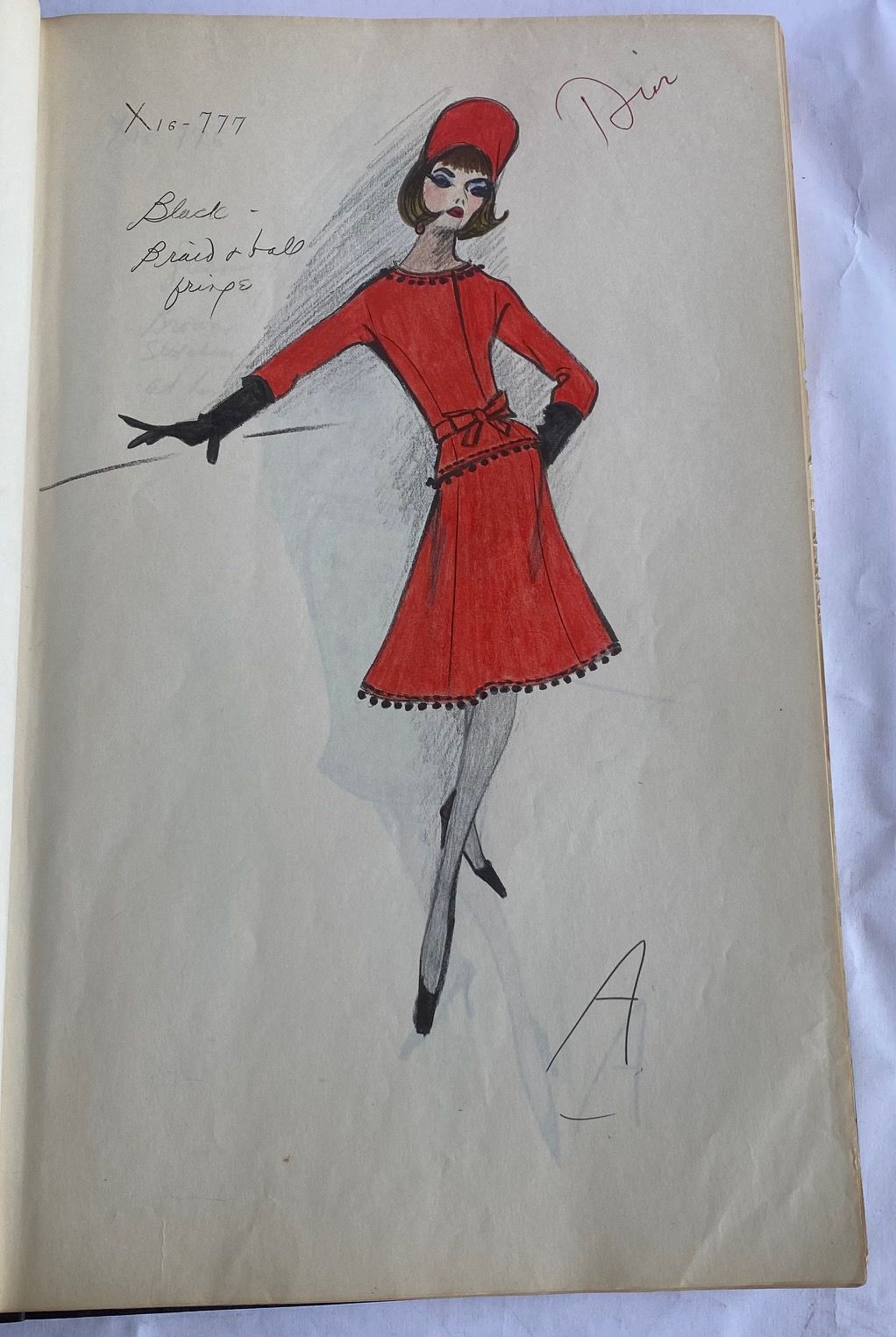
9.5" x 13.5" book with faux leather, flexible covers with "CARDINAL FASHION STUDIO, 1472 BROADWAY, NEW YORK CITY" printed on the cover. Inside this circa 1960s book, there are nearly 200 pages of photo-mechanically reproduced sketches by well-known fashion designers of the day. The first page lists different designers, some with red check marks next to them. The designers included here are Dior, La Roche, Balmain, Givenchy, Griffe, Lanvin, Chanel, Patou, Nina Ricci, Heim, Maggy Rouff, Gres, Cardin, and Goma. There are also a few sketches by Andre Courreges, though he is not listed at the front.
The sketches here were apparently drawn by artists working for Cardinal Fashion Studio in Europe, where they would go to the runway shows exhibiting haute couture fashions and capture the latest designs. Their sketches were then reproduced and distributed to clothing design companies in the United States to make less expensive ready-to-wear fashion.
Some of the sketches are black and white and others are in color. One page has a tape repair, and some bends to the top and bottom of the spine, otherwise it is in very good condition.
My thoughts went to Jaclyn Kennedy and Mrs. Maisel, as I thumbed through this book.
Offered by House of Mirth Photos.
The Children in the Wood; Or, the Norfolk Gentleman's Last Will and Testament
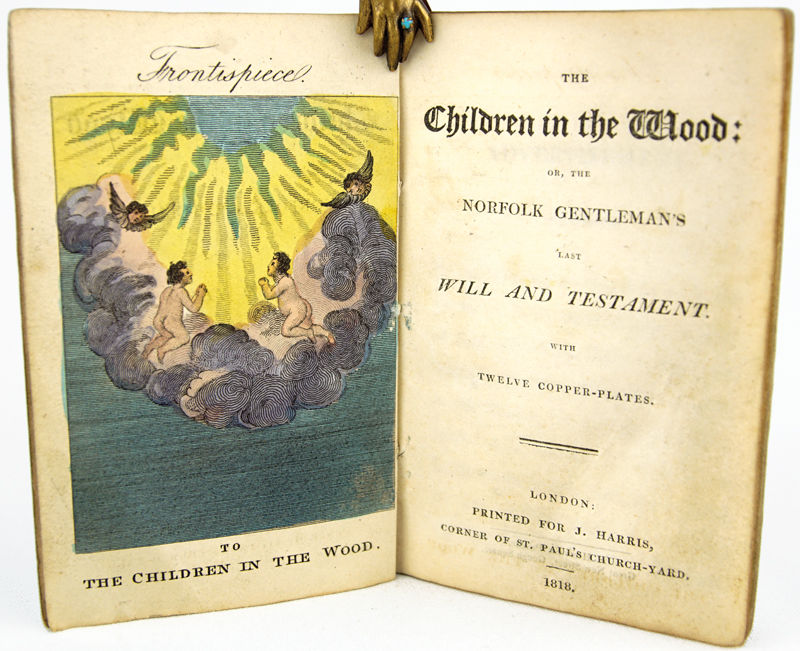
London: J. Harris, 1818. 32mo. 15pp., + 12 plates of engravings. Each illustration is fully colored and shows a remarkable depth of field and detail. These are not hasty sketches brushed by a disinterested hand; rather, they evince artful care and an eye for pleasing palettes. They grant a particular uniqueness to this edition of a well-known moral tale, here told in verse, of unfortunate children caught up in the conflicting greed and integrity of adults. Bound in tan printed wrappers, with publisher's advertisement to rear cover. Inch-long splits to head and tail of spine, else an impressively preserved copy, near fine. (Moon 126.2).
Offered by Bromer Booksellers.
1863 - Letter from a soldier in one of the most disgraced Union regiments of the Civil War reporting that it had been banished to Hilton Head Island as punishment for burning its barracks in Chicago and destroying a historic fence at Yorktown after it had been paroled following its ignominious surrender at Harper's Ferry
Jacob Brown
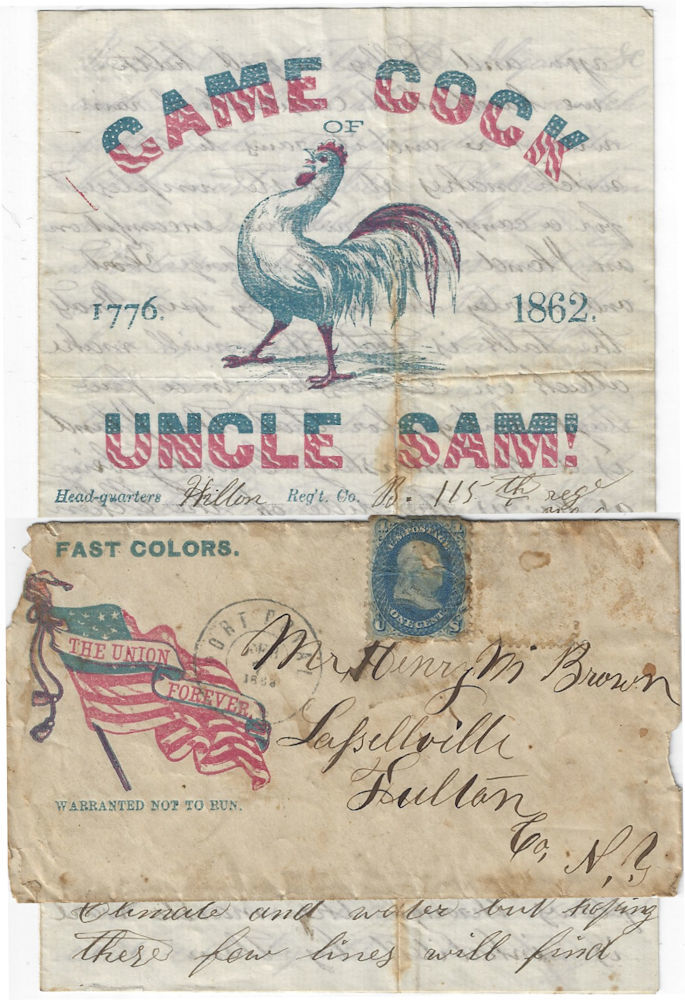
"[I am] confident of wat we was sent here for we was sent here under celled orders. . .. we was convicted and centenced by the secretary of war and sent here for Burning the Barracks and rase corse fense at Duglas Camp Chicago. . .."
Hilton Head, South Carolina. 1863
This four-page letter, sent by Jacob Brown to his father, is written on rather scarce patriotic stationery featuring a strutting rooster in red and blue, titled "Game Cock of Uncle Sam 1776 1862". It is datelined "Head-quarters Hilton Reg't Co. B. 115th regt / Hilton Head South Carolina Feb 6 1863". It is enclosed in its original worn and soiled patriotic mailing envelope featuring a U.S. flag bearing a streamer reading "The Union Forever" with a legend that reads "Fast Colors. / Warranted Not to Run" that was once franked with three 1-cent blue Franklin stamps; two are now missing. It bears a double-circle Port Royal [South Carolina] postmark dated "Feb 7 1862". A transcript will be provided.
The letter begins with a description of Hilton Head Island and a derogatory comment about African-Americans and President Lincoln's recent Emancipation Proclamation.
"I take the Plesher once more to write a few lines to you to let you now that we moved again and that I am well yet as can be expetted for the change of Climate. . .. we haved had considerable of rain wile here and it rains two day witch makes it quite unplesent. . .. we are encamp on an Iland here with a large Fort and nearley surronded by gun Boats. . .. this Iland is a low marshey Country being as low as the tide of the Ochen . . . witch makes it unhelthey in warm weather and the soil is of a light sand and wen the wind blows it puts me in mind of a northern Snow Storm. . .. the water we have to drink flows through the marsh [which] is inhabited by them Butiful reptiles the Aligater. . .. last of all the niger witch feel quite aristeratic under Old master Abes Blackamation. . .."
He then explains why his unit was reassigned to such an inhospitable place.
"[I am] confident of wat we was sent here for we was sent here under celled orders. . .. we was convicted and centenced by the secretary of war and sent here for Burning the Barracks and rase corse fense at Duglas Camp Chicago and our Pay stopt sinse we left yorktown the 22th of last month our Cornel is a going to Washington in a few day to have a reinstatement of the regiment. . .. it may go all wright yet eney way we will do the best of it. . .."
On August 1862, the 115th New York Volunteer Infantry Regiment broke camp at Fonda, New York and boarded train cars bound for Maryland to protect the Baltimore and Ohio Railroad. By 3 September, it had assumed defensive positions at Harper's Ferry along with three other regiments. Their positions left much to be desired and failed to neutralize the surrounding high ground. General Lee's Confederate Army was advancing up the Shenandoah Valley and elements of it surrounded Harper's Ferry emplacing 50 cannons on Maryland Heights and beginning a fierce barrage into the town. Although the defenders knew that a relief column was on the way, before the Confederate attack began in earnest, the Union defenders surrendered in mass, over 12,400 men, although having only suffered 44 soldiers killed.
As part of a parole agreement, it was sent to Chicago where it encamped at Camp Douglas and some nearby horse barns. There, quarters were poor, rations sparse and tainted, sickness common, and the soldiers sullen. By November, the troops refused to bear arms and conduct drill or perform guard duty. Regular army units brought in to control the mutiny were continuously pelted by stones and brickbats, eventually shooting at least one man who was trying to escape from camp.
Eventually, the 115th and other mutinous units were summoned to Washington, and just before they boarded the departing trains, the soldiers torched their barracks. Arriving in Washington, the 115th encamped at Arlington Heights where its men were employed as laborers to strengthen defensive positions, before being shipped to Tidewater, Virginia to do the same. While there, members of the regiment destroyed a historic fence at the Cornwallis surrender sight, breaking it into small souvenirs that "are now in thousands of northern homes, preserved as relics."
Finally, the War Department had enough; all pay and allowances were stopped, and after the 115th was formally released from parole, preparations were made to ship it to the desolation of Hilton Head, where the men were plagued by poisonous snakes, swarms of mosquitos and sand fleas, and alligators while they awaited an even worse assignment.
On February 7th, the day after Broun wrote this letter, the 115th arrived in Jacksonville, Florida to begin a thankless and failed campaign to drive Confederates from Florida's interiors. At the campaign's climax, the defeat at the Battle of Olustee, the 115th performed well although its casualty rate of 50%. This apparently placated the War Department, and subsequently, the 115th was allowed to return to Virginia, where it performed well at the Battle of Petersburg and Broun was killed.
(For more information about New York's 115th Volunteer Infantry Regiment, see Silo's recent publication, The 115th New York in the Civil War: A Regimental History, and Clark's hagiographic apologist history of his former unit, The Iron Hearted Regiment Being an Account of the Battles, Marches and Gallant Deeds Performed by the 115th Regiment N.Y. Vols. . ..)
A very scarce first-hand account of life in one of the most discredited Union regiments of the Civil War. Nothing similar is for sale in the trade, and no similar accounts have appeared at auction per the Rare Book Hub. OCLC suggests that similar letters may be in a collection held by the Clements Library at the University of Michigan.
Offered by Kurt A. Sanftleben.
Royal Tanning Co. Salesman's Sample Book
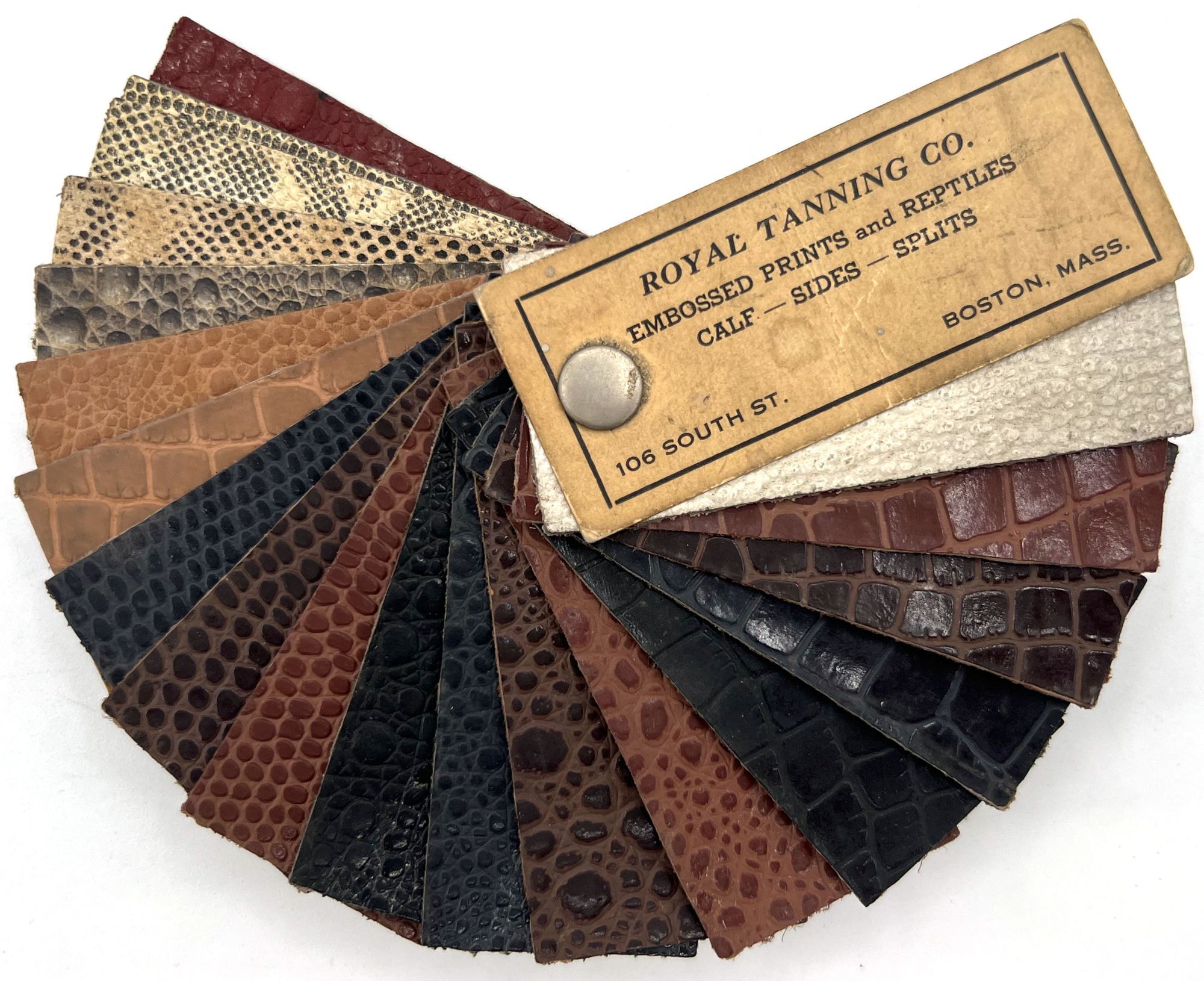
Boston, Massachusetts, 1920. Good to very good. Some minor dust soiling, wear.. Salesman's sample book of nineteen (19) different leathers, most of which appear to be calf, embossed to appear more exotic (e.g. crocodile, snake, lizard, etc.). Each sample measures approx. 3.5" by 1.5". Sample book measures 3.5" by 1.5" by 0.75", and features a printed title card with title and address.
Offered by Eclectibles.
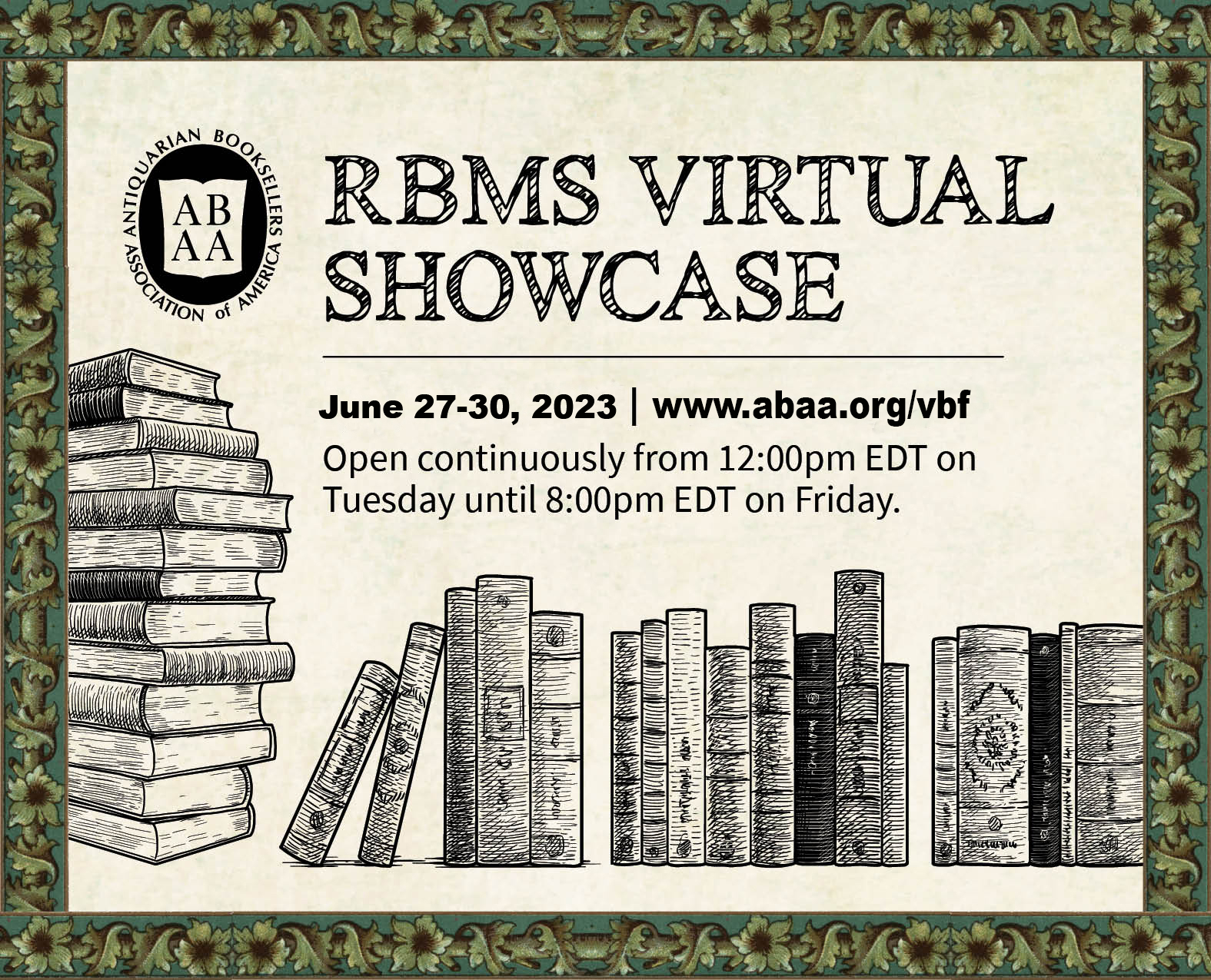
Curious who will be offering these items? Check back on the first day of the fair and we'll identify the sellers!


